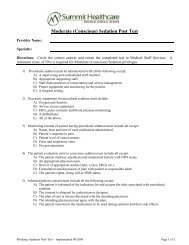active - Summit Healthcare
active - Summit Healthcare
active - Summit Healthcare
Create successful ePaper yourself
Turn your PDF publications into a flip-book with our unique Google optimized e-Paper software.
Treatment<br />
Treatment depends on the type of<br />
skin cancer and the extent to which it has<br />
spread. Basal and squamous skin cancers can<br />
be treated by:<br />
Mohs surgery. This is a special type of<br />
surgery for skin cancer that shaves one<br />
layer of cancerous tissue at a time. The<br />
tissue is immediately checked under a<br />
microscope to see if it contains cancer<br />
cells. The layers are removed until no<br />
cancer cells are found in the shaved cells.<br />
Curettage and electrodessication. In<br />
curettage, the cancer cells are scooped<br />
out using a special instrument called<br />
a curette. A special instrument applies<br />
an electric current to the area to stop<br />
bleeding and kill any cancer cells in the<br />
margin; this process is called electrodessication.<br />
Cryosurgery. This freezes the cells with<br />
liquid nitrogen, killing abnormal cells.<br />
Laser therapy. This uses a narrow beam<br />
of intense light to kill cancer cells.<br />
Chemotherapy. This uses drugs to kill<br />
cancerous cells. The drugs can be given<br />
orally, injected, infused intravenously (in<br />
a vein), or put right on the skin.<br />
Radiation. This uses high-energy rays<br />
(such as x-rays) or particles (such as photons,<br />
electrons, or protons) to kill cancer<br />
cells.<br />
Melanomas can be treated by surgery, chemotherapy,<br />
radiation, and biologic therapy,<br />
which are treatments that help the body’s<br />
immune system fight the cancer.<br />
Prevention<br />
Your exposure to UV depends on the<br />
strength of the sunlight, which is determined<br />
by where you live; the length of<br />
exposure; and whether you protect your<br />
skin with sunscreen and clothing. The areas<br />
of the body that receive the most sun exposure<br />
over a lifetime are the face, back of the<br />
neck, bald head, upper chest, forearms,<br />
backs of the hands, and lower legs. You<br />
can tell how much sunlight has changed<br />
your skin by comparing the sunexposed<br />
surfaces, such as the top of<br />
your forearm, with the inside of your<br />
forearm, which is usually protected<br />
from the sun.<br />
Sun exposure adds up, so protecting<br />
yourself from too much exposure is<br />
important. People can take simple steps to<br />
plan ahead and protect themselves from the<br />
sun’s UV rays. These options are important<br />
to remember year round and during all<br />
outdoor activities, and not just when at the<br />
beach or pool.<br />
Clothing<br />
Covering up with clothing is the best<br />
protection. Up to 80 percent of nonmelanoma<br />
skin cancers occur on the head<br />
and neck, so a wide-brimmed hat should<br />
be worn to shade the face, ears, scalp, and<br />
neck from the sun’s UV rays. A hat with a<br />
four-inch brim provides the most protection.<br />
If a baseball cap is worn, sunscreen<br />
with a sun protection factor (SPF) of at<br />
least 30 should also be used to protect the<br />
ears and neck.<br />
The best protection<br />
for the body<br />
is a long-sleeved<br />
shirt and long pants.<br />
Dark colors provide<br />
better protection<br />
than light colors.<br />
Wet fabric gives<br />
less protection than<br />
dry. Some clothing<br />
has SPF protection<br />
added; a typical<br />
shirt, however,<br />
has an SPF rating<br />
substantially lower<br />
than the recommended<br />
SPF 15, so<br />
it is wise to double<br />
up on protection by using sunscreen with<br />
at least SPF 30 and staying in the shade<br />
when possible.<br />
Seek shade<br />
Because the sun’s UV rays are strongest<br />
and do the most damage during midday,<br />
outdoor activities should be avoided at this<br />
time. If this is not possible, then finding the<br />
shade of a tree, beach umbrella, or tent is a<br />
practical way to protect<br />
the skin.<br />
Sunscreen<br />
There are two types of sunscreens:<br />
Physical sunscreens, such as zinc or titanium<br />
oxide, contain particles that scatter<br />
and reflect sunlight from the skin.<br />
Chemical sunscreens, which absorb<br />
radiation.<br />
Sunscreens generally do a good job filtering<br />
out the UVB rays, which cause sunburn.<br />
But most sunscreens don’t defend nearly as<br />
well against the UVA rays. That’s true even<br />
for some products labeled ‘’broad-spectrum<br />
UVA/UVB protection.”<br />
SPF refers only to protection from<br />
UVB rays. SPF 15 blocks about 93 percent<br />
of UVB rays, and SPF 50,<br />
often more expensive,<br />
blocks about 98 percent. A<br />
higher SPF rating does not<br />
mean you can spend more<br />
time in the sun.<br />
Experts say the best<br />
protection against UVA is a<br />
sunscreen that includes zinc<br />
oxide, titanium dioxide,<br />
oxybenzone, or avobenzone.<br />
Most people do not apply<br />
enough of the sunscreen<br />
to get the full SPF rating.<br />
An adult should use enough<br />
sunscreen to fill a shot glass<br />
and use it to cover arms,<br />
legs, neck and face. If you are using insect<br />
repellant or other lotions, apply the sunscreen<br />
first.<br />
For adults and children, sunscreens<br />
should be applied 20 to 30 minutes before<br />
exposure and every two hours afterward, as<br />
well as after swimming or sweating.<br />
Babies younger than six months should<br />
be kept out of direct sunlight and protected<br />
from the sun using hats and protective<br />
clothing. Sunscreens should not be used on<br />
infants younger than six months, unless adequate<br />
clothing and shade are not available.<br />
Use a lip balm with sunscreen to<br />
protect lips.<br />
Sunglasses<br />
Sunglasses protect the tender<br />
skin around the eyes and reduce the<br />
risk for developing cataracts. Look<br />
for sunglasses that block both UVA<br />
and UVB rays. Wrap-around lenses are<br />
ideal because they keep UV rays from<br />
hitting the sides of the eyes.<br />
<strong>Summit</strong> Active 4






